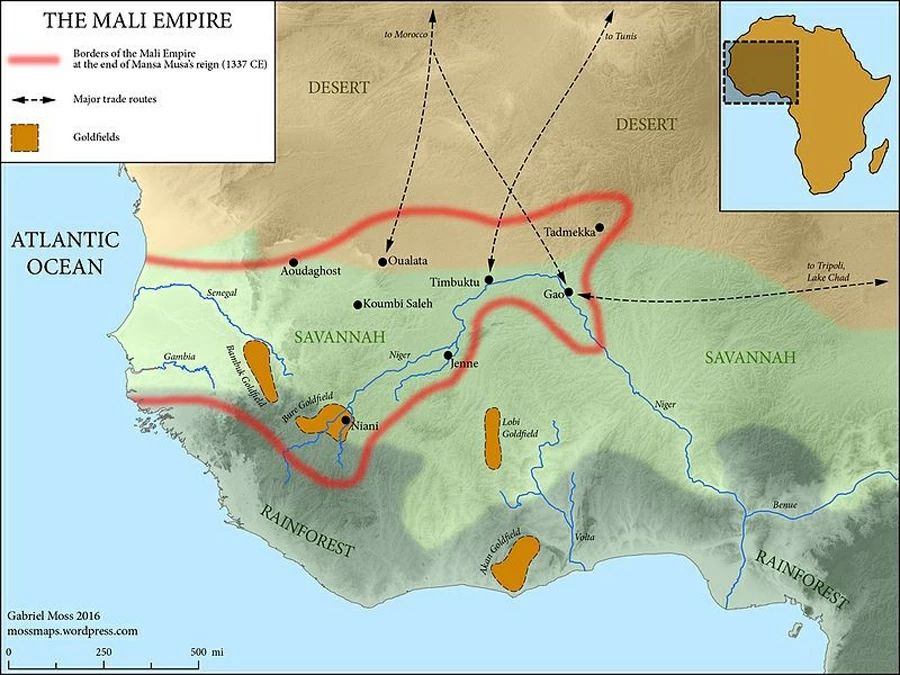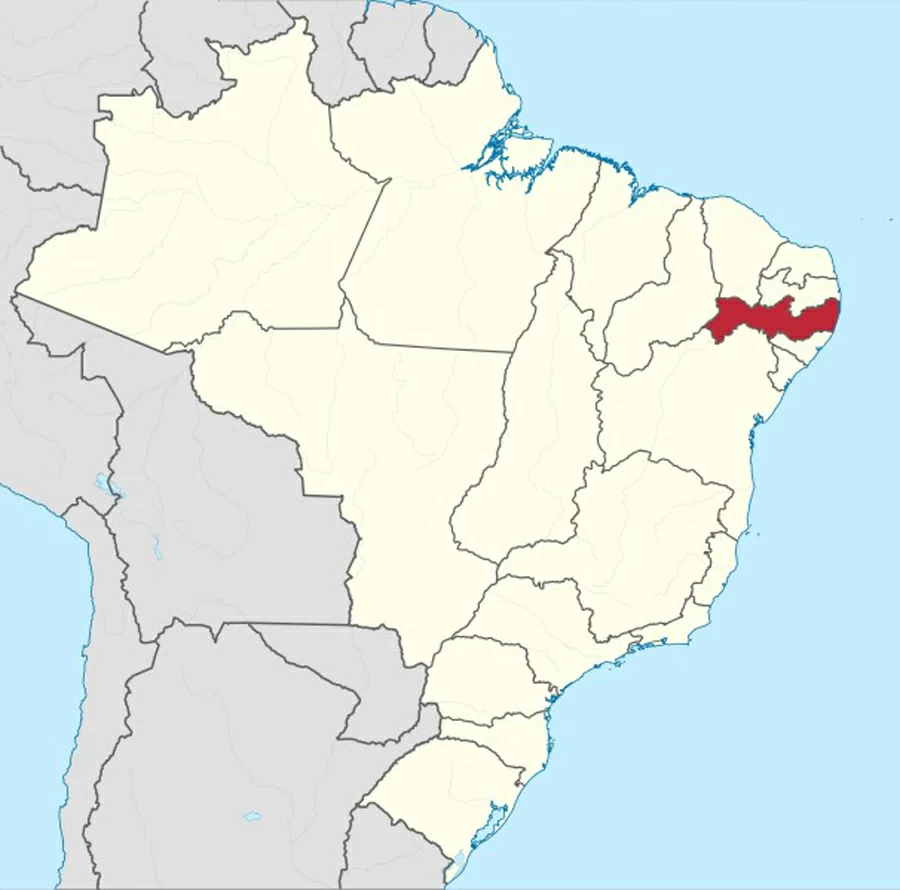History books still teach children that Christopher Columbus initiated the first contact between the Americas and the rest of the world. The great explorer opened up the new continent to trade, conquest and destruction.
But as new discoveries are made, this version of events becomes more and more threadbare. A penny in Maine referring to King Olaf of Norway seems to point to Scandinavian settlers in the 11th century.
Sweet potatoes crossed the Pacific from South America to Easter Island and even Polynesia tens of thousands of years earlier, and apparently Polynesian languages even include loan words for the tubers, suggesting human contact. And from Africa come stories of a great king who took a long sea voyage to the Americas, 200 years before Columbus.
The king or “Mansa”, Abu Bakr II, ruled the Mali Empire in central Africa in the 14th Century. He is said to have led the Malian sailors to the Americas, landing in what is now Brazil.
200 Boats
Abu Bakr II was the ruler of the largest and richest empire on the whole earth at that time, covering almost the entirety of West Africa. His successor, Mansa Musa, is famously considered the richest man to have ever lived, and related the story of Abu Bakr’s journey to an Egyptian dignitary.
Abu Bakr had expanded his empire to the coast of the Atlantic Ocean, along the Niger river that connected the Atlantic Ocean through to Mali. Faced with an apparent limit to his domain, the powerful ruler became fixated with what could be beyond the sea.

The Mansa theorized that another shoreline could exist across the ocean, out of sight, and he was determined to reach this land. So, to fulfill his quest, he ordered 200 boats suitable for the crossing to be built and equipped with and Malian sailors.
He certainly had the resources for such an undertaking. His uncle and predecessor, Soundjata Keita, founded the Mali Empire in around 1235, taking a large stretch of the Sahara Desert and many forests of the West African coast under his control.
Abu Bakr II also had access to the expertise of the engineers of Lake Chad, who knew how to build the best of ships. He wanted his ships to evoke those of the ancient Egyptians, and studied all of the best ships that sailed around the Senegal and Djoliba rivers.
He also hired a large crew of builders, artists, learned men, warriors, traders, and sailors to accompany the expedition. He also made sure the ships carried sufficient rations for a voyage of two years.
The fleet of 200 ships would communicate with each other during the voyage through a drum system. In splendor, some time in the early 14th century, the expedition set off into the Atlantic. What happened next is unclear.
The Witness and the King’s Voyage
All evidence relating to this first voyage comes from a single ship which was forced back to Mali, crewed by a single captain. He reported to Abu Bakr II and the Imperial court that, after a few days at sea, the ships were all stuck by powerful ocean waves and currents.
Scattered by the weather, the captain lost sight of the other ships and could no longer hear the drums to guide him. Hearing this news, the king made the decision to prepare another expedition of 2,000 ships, and this time he would go on the journey himself.
Abu Bakr II handed over the throne to this brother, named Kankou Moussa, and when his second fleet was ready and equipped, he started his journey for the unknown lands in 1311 or 1312.
The emperor of Mali gave up all his luxury, power, and gold for the sake of pursuing knowledge and discovering new things around the globe. After he handed over the throne to his brother, Kankou Moussa was given the title of Mansa Musa.
Frustratingly, the outcome of this voyage is also unclear. Some historians believe that Mansa Abu Bakr II was never heard from again. However others, noting the huge wealth ascribed the Abu Bakr II’s successor, believe that this must have come from a successful trip to the New World.
Boure Bambouk and the Tupi
There is some tantalizing evidence that Abu Bakr II reached the Americas. It is said that he named this land “Boure Bambouk” after the rich Mali gold fields, deciding to rule here and leaving Mali to his brother.
- Kensington Runestone: Made By Vikings or a Forger?
- Africa’s Strange Ruin: What Exactly Is Great Zimbabwe?
Three years passed within the fledgling colony of the discovered land, under the rule of Abu Bakr II. Within the first three years, he successfully established a sustainable colony on the Brazilian coast.

Abu Bakr II then established contact with the Tupi tribes of that region, establishing trade links. With this trade, the new colonists became acquainted with crops of the New World, including beans, peanuts, cotton, tropical fruits, and tobacco.
These agricultural staples fed the new colony and allowed it to grow. In return, Old World livestock such as sheep, guinea fowl, and cattle were introduced to the Tupi tribe.
Following that, sorghum, riche, and millet were also brought in for trading, and in the year 1314, Abu Bakr II sent a boat back to Mali with a petition to send more support. More crops and settlers were sent to Boure Bambouk and the Atlantic apparently proved no obstacle to trade between the new colony and the empire.
A True History of Abu Bakr II?
This would seem to be pretty clear cut evidence that Abu Bakr II reached the Americas before Columbus, but there are several questions over Boure Bambouk and the Brazilian colony.
The story of Mansa Abu Bakr II comes from his brother, but Mali does not record a mansa of that name ruling before Mansa Musa. The location of the supposed colony is unknown, and there is no surviving evidence from the Malian empire of New World trade.
However, some evidence does survive on the other side of the Atlantic. Tiemoko Konate, head of a project to trace the journey of Abu Bakr II, said to BBC that Columbus himself found African traders already present in the Americas when he landed.

Moreover, chemical analysis of gold tipped spearheads that Columbus traded for in America indicate a west African origin. Mali was naturally rich in gold, and the perishable goods Abu Bakr II would have traded the gold for would not have survived to provide modern evidence.
Was this simply a story told by the Malian ruler to impress his Egyptian guests? Or should Abu Bakr II take his rightful place in history as the king who travelled across the Atlantic to find the New World? Hopefully, one day the truth will out.
Top Image: Mansa musa told of his brother’s journey to the New World. Source: HistoryNmoor / CC BY-SA 4.0.
By Bipin Dimri